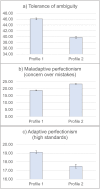Temperament and character profiles of medical students associated with tolerance of ambiguity and perfectionism
- PMID: 31223537
- PMCID: PMC6571128
- DOI: 10.7717/peerj.7109
Temperament and character profiles of medical students associated with tolerance of ambiguity and perfectionism
Abstract
Background: Certain personal attributes, such as perfectionism and tolerance of ambiguity, have been identified as influential in high achieving students. Medical students have been identified as high achievers and perfectionistic, and as such may be challenged by ambiguity. Medical students undertake a long and challenging degree. Personality has been shown to influence the well-being and coping and may equip some students to better cope with challenges. This paper examines the association between temperament and character personality profiles with measures of tolerance of ambiguity and with both adaptive and maladaptive constructs of perfectionism.
Methods: A self-report questionnaire collected data on a sample of 808 Australian medical students in 2014 and 2015. Personality was measured using the Temperament and Character Inventory (TCIR-140) and classified traits as profiles using a latent class analysis. Two profiles were found. Profile 1 was characterized by low-average levels of Harm Avoidance, and high to very high levels of Persistence, Self-Directedness and Cooperativeness. Moderately-high levels of Harm Avoidance and high levels of Persistence, Self-Directedness and Cooperativeness characterized Profile 2. Moderation regression analyses were conducted to examine the association between the personality profiles with levels of Tolerance of Ambiguity (MSAT-II), Perfectionism-Concern over Mistakes and Perfectionism-High Standards (FMPS), considering demographic characteristics.
Results: Students with Profile 1 were higher in levels of Tolerance of Ambiguity, and Perfectionism-High Standards, and lower levels of Perfectionism-Concern over Mistakes compared to Profile 2. These findings remained statistically significant after adjusting for age and gender. A significant personality by age interaction on Tolerance of Ambiguity was found. While higher levels of Tolerance of Ambiguity were associated with older age overall, it remained low across age for students with a personality Profile 2.
Conclusions: A particular combination of personality traits was identified to be associated with low Tolerance of Ambiguity and high levels of maladaptive Perfectionism. An intolerance of ambiguity and over concern about mistakes may be maladaptive and underlie vulnerability to stress and poor coping. The psychobiological model of personality provides insight into traits that are stable and those that can be self-regulated through education and training. The interaction between biological mechanisms and socio-cultural learning is relevant to a sample of medical students because it accounts for interaction of the biological or innate aspects of their personal development within an intense and competitive learning environment of medical school.
Keywords: Age; Coping; Medical students; Perfectionism; Personality; TCI-140; TCI-R; Temperament and character inventory; Tolerance of ambiguity; Well-being.
Conflict of interest statement
Diann S. Eley and Robert Cloninger are Academic Editors for PeerJ. Kevin M. Cloninger is employed at The Anthropedia Foundation.
Figures



References
-
- Borges NJ, Osmon WR. Personality and medical specialty choice: technique orientation versus people orientation. Journal of Vocational Behaviour. 2001;58(1):22–35. doi: 10.1006/jvbe.2000.1761. - DOI
LinkOut - more resources
Full Text Sources

